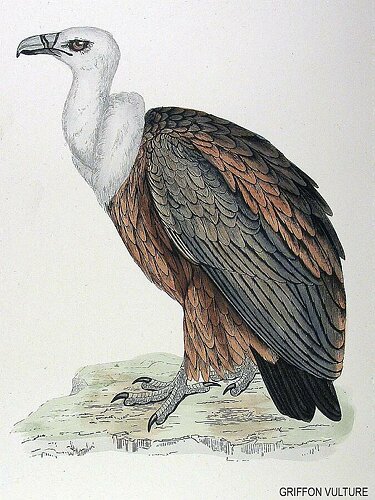GRIFFON VULTURE.
Gyps fulvus, GRAY. Gyps vulgaris, SAVIGNY. Vultur fulvus, GOULD. Gyps—A
Vulture. Fulvus—Yellow—tawny.
The Griffon Vulture is an inhabitant of various parts of Europe Asia,
and Africa, regardless alike seemingly of cold and heat. It is met
with in Turkey, Greece, the Tyrol, and Silesia, on the Alps, and the
Pyrenees, in France, Germany, Dalmatia, and Albania, the Grecian Archipelago,
Candia, Sardinia, Spain, and Algeria; Egypt, Tangiers, Tunis, and
other parts of the African continent, and is particularly abundant
on both sides of the Straits of Gibraltar, and as it has once been
known, as presently mentioned, to visit this country, it may be hoped
that it may again be met with here.
Like the rest of its congeners, this bird feeds on carrion, and thus
performs a useful part in the aeconomy of nature. Occasionally it
will attack weak or sickly animals but this is only as a 'dernier
resort' and when it cannot supply its appetite by the resources which
are more natural to it. Thus, Vice versa' the Eagle, whose congenial
prey is the living animal, will, when forced by the extremity of hunger,
put up with that food which under other circumstances it rejects and
leaves for the less dainty Vulture.
When the Griffon meets with a plentiful supply of carrion, it continues
feeding on it, if not disturbed, which it easily is by even the minor
animals, until quite gorged, and then remains quiescent until digestion
has taken place: if surprised in this condition, it is unable to escape
by flight, and becomes an easy capture. It feeds its young, not by
carrying food to them in its talons, as is the habit of the Eagles,
Falcons, Hawks, and Owls, but by disgorging from its maw part of what
it had swallowed.
Only one example of this grand addition to British ornithology has
as yet occurred. A single specimen—an adult bird, in a per¬fectly
wild state, was captured by a youth, the latter end of the year 1843,
on the rocks near Cork harbour, and was purchased for half-a-crown
for Lord Shannon, by whom, when it died, it was presented to the colletion
of the Dublin Zoological Society.
This species, like the rest of its kindred, possesses great powers
of flight, though it is not rapid on the wing, and often soars upwards,
almost always spirally, until it has become invisible to the human
eye; it descends in the same manner in circles.
It builds its nest, as might be expected, on the highest and most
inaccessible rocks, or sometimes on lofty trees, but in the winter
it frequents more the lower and open grounds. The structure is three
or four feet in diameter.
The eggs, laid early in March, commonly one, but occasionly two or
three in number, are of a dingy white colour, sometimes marked with
a few pale red streaks and blots.
The young are hatched the beginning of April.
The male and female are scarcely distinguishable, except in size—the
former being smaller than the latter, as is the case generally with
birds of prey; why, it is extremely difficult to say. Some reasons
which have been advanced must at once be pronounced unsatisfactory.
The length of this bird is about three feet eight inches. The bill
is by some described as bluish lead-colour; by others as yellowish
white or horn-colour; the cere, bluish black; iris, reddish orange,
The head and neck are covered with down, which, as well as the ruff
round the neck, and which is of the same material, is dull white;
the eyes are margined with black. The upper and middle part of the
breast also dull white, mixed with light brown, the lower part reddish
yellow brown. The expansion of the wings eight feet. The back, and
the greater wing coverts, light yellowish brown, the shafts lighter
brown; the larger under wing coverts, dull white; lesser under wing
coverts, light brown; primaries, dark brown; the tail the same colour.
The legs and toes lead-colour, the former reticulated, the latter
each with six large scales in front; the claws black.
Immature birds differ very considerably in plumage from those which
have attained to the adult state; the former are much spotted
all over, and the down on the head and neck is conspicuously marked
with brown.
